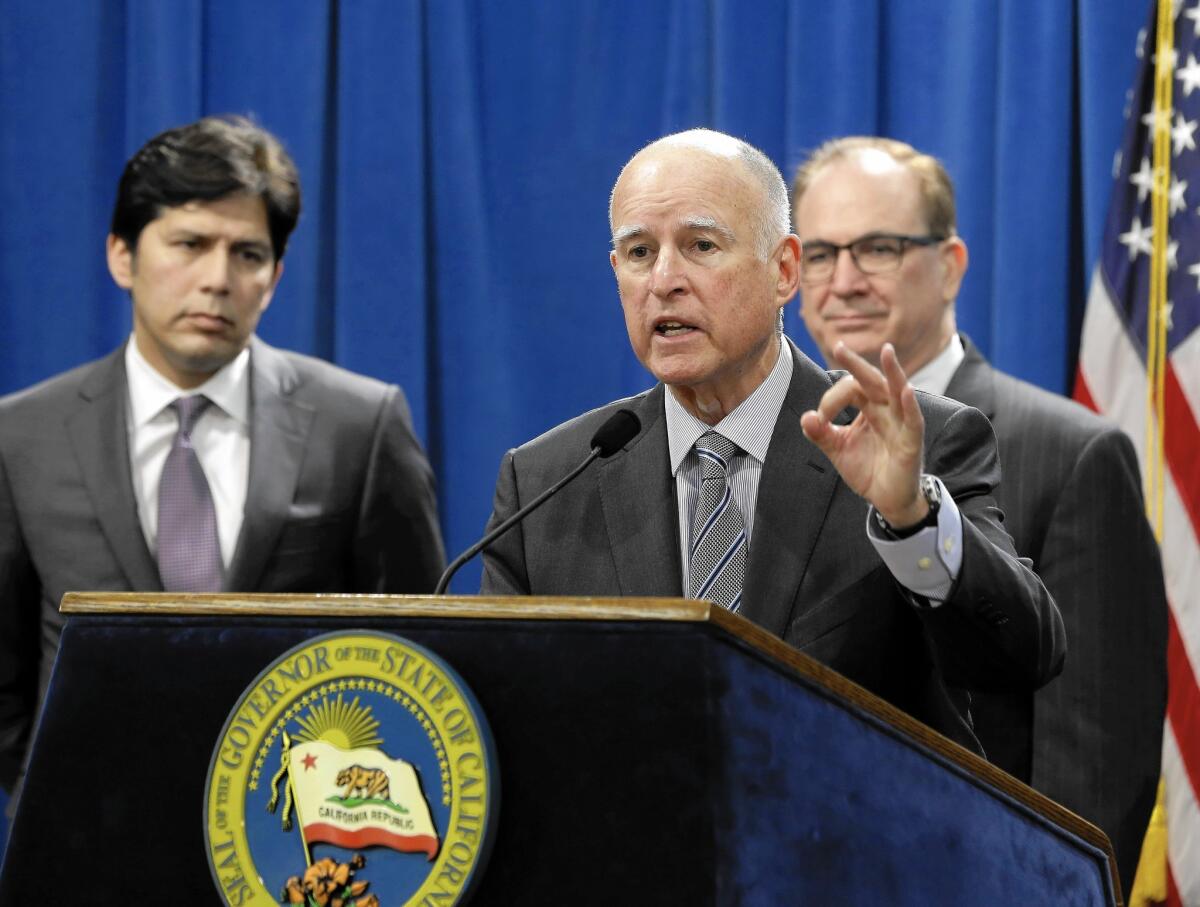Capitol Journal: Thirsty crops should require state regulation

- Share via
SACRAMENTO — This is what the Brown administration isn’t talking about as it tightens the spigot on landscaping: Urban use accounts for only 20% of California’s developed water. Agriculture sucks up 80%.
Some calculate it a little differently: 10% urban, 40% agriculture and 50% environment — meaning every drop in the rivers and marshes. Same thing.
Yet, no one in Sacramento wants to tell farmers how to use water — what they can and cannot plant and irrigate.
No edicts equivalent to “lawn-watering only twice a week” or “hosing down the driveway is forbidden.”
No such directives as “tomatoes are OK because they’re not water guzzlers and can be fallowed in a dry year,” but “hold off planting more gulping almond orchards in the desert.”
Maybe, however, it’s time for state government to consider regulating crops based on their water needs as California’s drought lingers menacingly and we head into the uncertain future of global warming.
After all, we think nothing of telling other landowners what they can put on their property.
We don’t allow a new housing tract to sprout unless the developer can identify a source of water. We zone everything in urban areas — requiring government permission to build a house, a strip mall, a factory or a refinery.
Yet, a farmer can plant whatever he pleases, even if surface water is flowing at a trickle and the aquifer is collapsing.
This is what Times water reporter Bettina Boxall wrote last week: “Parts of the San Joaquin Valley are deflating like a tire with a slow leak as growers pull more and more water from the ground.
“The land subsidence is cracking irrigation canals, buckling roads and permanently depleting storage space in the vast aquifer that underlies California’s heartland … hastening the day, experts warn, when [farmers] will be forced to let more than a million acres of cropland turn to dust…. [But] it’s easier for growers to keep pumping than rein in their use.”
In one area of the San Joaquin Valley, Boxall reported, the “land has been sinking at the staggering rate of a foot a year.” And the groundwater table has plunged 150 feet in the last 15 years.
There’s no longer a drought buffer.
And it’s getting harder for arid regions to just grab water from wetter areas, as L.A. shamefully did a century ago in draining the Owens Valley in the Eastern Sierra, providing a story plot for the movie “Chinatown” and paving the way for developer riches and SoCal sprawl.
Gov. Jerry Brown is having a tough time trying to build his proposed $25-billion twin tunnels under the Sacramento-San Joaquin River Delta. They would siphon fresh Sacramento River water, rerouting it from delta farms to San Joaquin growers.
Crop production and food processing, incidentally, account for only about 2% of California’s gross product.
All these figures — shares of water consumption and economic impact — come from the nonpartisan Public Policy Institute of California, among other credible research centers.
No one is arguing that California shouldn’t be tightening up on urban landscaping, as the state Water Resources Control Board did last week. It’s needed.
But the savings amounts to a drop in the bucket compared to what agriculture uses. Residential and commercial landscaping account for just half of urban water use, or 10% of California’s total.
The big state and federal water projects have been reducing flows to San Joaquin Valley farms. But growers are trying to recapture the loss by digging deeper wells and depleting the groundwater. That’s unsustainable.
To their credit, Brown and the Legislature last year did enact a historic law to manage groundwater. But we were the last Western state to do that. Central Valley agriculture fiercely fought it.
The bill punted the regulating chore to local governments, giving them 25 years to make groundwater pumping sustainable. If they fail, the state can step in.
Perhaps as part of that management, local governments will tell farmers what crops they can plant. But don’t count on it. This is seen as a radical idea.
“It’s a hard place to go,” says Felicia Marcus, chairwoman of the state water board. “The premise is that farmers have water rights. They make business decisions and take a risk.”
At a news conference last week announcing a $1-billion “emergency drought package” — basically expediting spending previously approved by voters — Brown said there’d be more restrictions on farmers.
“Growing a walnut or an almond takes water,” the governor noted. (No kidding: One gallon is needed to grow one almond, it’s generally agreed.)
“Having a new house with a bunch of toilets and showers takes water,” Brown continued. “So how do we balance use efficiency with the kind of life that people want in California? That’s the wisdom.... There will be restrictions for growers, for consumers, for home builders and for home dwellers.”
Marcus told me the agriculture restrictions won’t involve planting-dictates. They’ll involve reducing delta flows to previously protected “senior” water rights holders, those with rights attained before 1914. The state board also will target any ag water, she says, deemed wasted.
Brown put it all in perspective with this opening comment:
“California for 10,000 years had only 300,000 or so residents. When you up that to 38 million and you increase the amenities and the consumption, you get a problem when you’re in the middle of a desert.”
The solutions: recycling, conservation, desalination, more storage — and crop regulation.
Twitter: @LATimesSkelton
More to Read
Sign up for Essential California
The most important California stories and recommendations in your inbox every morning.
You may occasionally receive promotional content from the Los Angeles Times.











